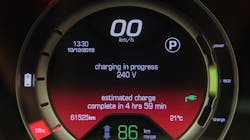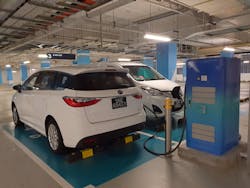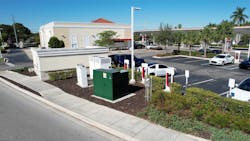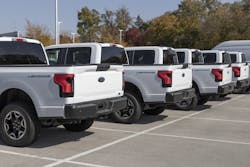These discussions are happening just about everywhere today, including at the National Rural Electric Cooperatives Association, which featured quite a few sessions on the impact of EVs on grid reliability. If more utility people are talking about EVs, it’s because, for one thing the profile of the EV user is beginning to shift.
Another factor is the growing industry chatter about EV fleets for commercial, industrial and institutional customers such as universities, governments, armed forces and utilities themselves.
C&I entities adopting fleets of thousands of EVs at once could have a much heftier impact on overall EV numbers than individual consumers opting to go electric. The International Energy Agency has called the sales growth of EVs “exponential.” A total of 14% of all new cars sold were electric in 2022, up from less than 5% in 2020, the IEA said in its 2023 Global EV Outlook.
According to the McKinsey Group, around 48 million EVs would create an annual charging demand up to 230 billion kWh and require installing nearly 30 million chargers. That survey is limited to the U.S., which is only in third place for new EV sales, with China and the E.U. in the top two spots.
These are not small numbers, so a touch of alarmism among those whose job is to keep the lights on is understandable. The pace of EV adoption seems to be entering its long-predicted speeding up phase.
Overloading Grid Assets
Jow Ortiz, General Manager Utilities for Ubicquia, said utilities are concerned about the sheer size of the predicted EV loads, adding that today they can’t detect EV load at the transformer level and proactively plan for it.
“They are seeing overcapacity circuits and failed transformers due to EV load even today,” Ortiz said. “They are concerned about fleet EV operations that can require a significant distribution grid infrastructure investment to accommodate – do they have the funding to make these investments and will they be recompensed for doing so?”
Other concerns include low quality inverters being used in EV charging systems that backfeed electrical transients into the grid that can overheat and damage distribution transformers. Peak demands are worsening as Level 1 chargers are replaced with Level 2 fast chargers, which enable drivers to charge more quickly at a hidden cost to grid operators.
It should be noted this comes at a time when transformers of all kinds, from the large pad-mounted units to less powerful pole-top varieties, are seeing longer lead times for replacements due to a combination of fast-growing demand and supply challenges.
A study by Car & Driver found that the charging capacity required to supply a large passenger vehicle travel center or truck stop site would be “roughly equivalent to the electric load of a small town.”
“The electric utilities would need considerable distribution system upgrades, along with transformer capacity, to support these EV connections,” Ortiz said.
Rapidly expanding EV adoption could have a cascading effect on energy systems everywhere, requiring a massive buildout of charging infrastructure as well as grid modernization technology, said Jason Plane, Utility Segment Manager – North America, for Eaton.
“However, electrification is not just about adding new load to the grid (or building, industrial or home energy systems). It requires that existing energy systems work smarter and harder to meet demand while accelerating decarbonization and optimizing how energy is consumed through intelligence, control and automation,” Plane said.
“Most EVs today have a range of 250 miles (400km) and as battery technology continues to improve, cars will go ever further. More charging infrastructure is coming thanks to policy directives, government funding and incentives. The economics of going electric also prove out, with savings for consumers in both fuel and maintenance,” Plane said.
These economic shifts are leading to a change in the profile of the typical EV user that most of us picture in our heads: a college-educated, urban early adopter, said John Glassmire, Global Product Manager for e-mobility, Grid Edge Solutions at Hitachi Energy.
“Historically, the stereotypical profile of an EV user has been a homeowner in an urban area, and from a state like New York or California that has more aggressive emissions standards and decarbonization goals. However, with decarbonization efforts on the rise and an uptick in the passing of policies – like the Biden Administration’s recently announced standards for a national EV charging network – the profile of the EV user is evolving,” Glassmire said.
As EVs become more widely available, and businesses and communities electrify their private and public vehicle fleets, we might see concentrated areas of EV chargers that will require new infrastructure solutions to meet their high-power demands, he said
“We’ll also see a shift to accommodate the charging demands of public transportation in both private and public charging hubs,” Glassmire said. “Medium-duty fleets of vehicles, like those that handle last-mile delivery for goods and packages, are just beginning to benefit from what EVs have to offer. EVs enable medium-duty fleets to meet emissions goals, reduce vehicle operating costs, and operate more efficiently and sustainably, offering next-level flexibility and reliability with the availability of new smart charging infrastructure.”
Preparing for the EV Rev Up
Located in Virginia, the Rappahannock Electric Cooperative services 22 counties from the Blue Ridge Mountains to Chesapeake Bay. The cooperative serves more than 170,000 connections over 17,000 miles of line the cooperative has areas of high density and rural areas throughout.
Eugene Hamrick, Rappahannock’s Director of Enterprise Analytics and Innovation, said C&I customers as well as residential customers in his service territory are going electric in greater numbers.
“Growth has varied, but more and more members, both residential and commercial have started to purchase electric vehicles. Most of our employees don’t go a day on the road without seeing a Tesla, that was not the case 4 years ago,” Hamrick said.
“Adoption is low at around 1% but we anticipate a significant amount of adoption in the late 2020’s and early 2030’s increasing anywhere from 15% to 40% over the next 15 years,” Hamrick said. “Grid resiliency is top of mind and one of the biggest challenges to prepare for is ‘Can we sustain every residential Level 2 charger charging at the same time right before a winter storm?’”
To address these concerns and others, REC developed BrilliT, an IT, cybersecurity and data analytics unit. Hamrick said in preparation for the impact of EVs, BrilliT developed an analytics model and several business intelligence dashboards to identify, analyze and provide key actionable insights around EV member readiness.
This includes analysis of DC fast chargers at key locations, transformer loading analysis to keep an eye on transformers serving Level 2 chargers, a ZIP code level analysis of EV adoption including forecasting and more.
“It is essentially and part of REC and BrilliT’s analytic strategy to proactively understand and put in place rate incentives to shift charging to off peak times to help control and reduce wholesale costs to the membership. Not doing so and not utilizing the data to make an impact could result in enormous increases in energy costs from coincident peak,” Hamrick said.
Quickening Pace
Maria Kretzing, Director of Innovation, Product Management at Bidgely, said everyone should expect demand to increase by at least 30% to 40% in the coming years. As EV penetration gets closer to 50% in the 2030s, we could see a doubling of electricity demand.
“Now the important thing about that is where the demand will come from. Current adoption rates and trends will not create the same ratio of increase across the grid, and we’re going to see early demand spike in very specific places. Hotspots will pop up because adoption is a localized effect where in large cities, or even states like California, you’re going to see the effects there far, far sooner than you’ll see them in the Midwest,” Kretzing said.
“Utilities are very concerned with this. They’re wary of overloading transformers where high EV adoption areas, what we call hotspots, are developing. They need to take immediate action to accommodate this new load, such as up-sizing a transformer. We’re already seeing problems like this in California,” Kretzing said.
S&P Global Market Intelligence estimates that EVs globally could soon require more than three times the energy demand currently used by California (between 525 TWh and 860 TWh), which as is often pointed out, is the world’s fifth largest economy.
If utilities can evolve to bring on these new EV enabling technologies, there are a lot of tools available to help meet this exponential demand, Glassmire said.
“If improperly managed, the power that would need to flow through the grid could potentially create serious issues. However despite the scale of this challenge, with coordinated and managed charging – particularly charging optimized to align with grid capacity and renewable production – many of these challenges would be overcome,” Glassmire said.
Flexing Data Muscles
Using analytics systems, developing new forecasting models and leveraging distributed energy resources where it makes sense to do so, utilities may be able to stay on top of growing demand.
“EV adoption will come faster and sooner than you think,” Glassmire said. “The longer we wait to prepare the grid for electrification, the more expensive it will become; the time to invest is now.”
Utilities can improve reliability and local capacity by deploying renewable microgrids and other grid edge solutions to meet the needs of clusters of charging stations and other DERs.
“EVs are, in effect, a new distributed energy resource for the grid. In many cases, they will also serve as critical infrastructure since they are used to drive people and businesses around. However, they are also flexible and can be dispatched based on the capacity of the grid and other local DER when they are plugged in,” Glassmire said.
“An overarching challenge is that electrification is likely to appear sooner and grow faster than many anticipate. If utilities can evolve to bring on these new EV enabling technologies, there are a lot of tools available to help meet this exponential demand,” Glassmire said.
Ortiz said the technology solutions to meet the growing EV adoption will include re-modeling grid infrastructure to support more grid capacity along major highways and roadways that support fleet operations and extension of sub-transmission grid solutions deeper into the distribution grid.
“Additionally, distribution transformers that support EV charging infrastructure will need to be sized with adequate capacity to accommodate these new loads – in many cases requiring 3 phase distribution transformers where single phase transformers have historically been placed,” Ortiz said.
Other technology solutions will require a means to accurately measure the EV charging loads — both demand and consumption loads with timestamps.
“Transformers today do not have means to measure EV load separate from other electrical loads. Solutions like ours that can be retrofitted to existing distribution transformers to monitor transformer loading and health will become requisites to enable EV charging sites to include ‘smart transformers.’” Ortiz said.
EV charging infrastructure can also back feed harmonics and other electrical distortion back onto the distribution transformers, which can create excessive heating of the transformers. Being able to detect both the presence of EV attachment loads to the transformer and whether there are electrical disturbances fed back into the transformers will become necessary for utilities, Ortiz said.
About the Author
Jeff Postelwait
Managing Editor
Jeff Postelwait is a writer and editor with a background in newspapers and online editing who has been writing about the electric utility industry since 2008. Jeff is senior editor for T&D World magazine and sits on the advisory board of the T&D World Conference and Exhibition. Utility Products, Power Engineering, Powergrid International and Electric Light & Power are some of the other publications in which Jeff's work has been featured. Jeff received his degree in journalism news editing from Oklahoma State University and currently operates out of Oregon.




